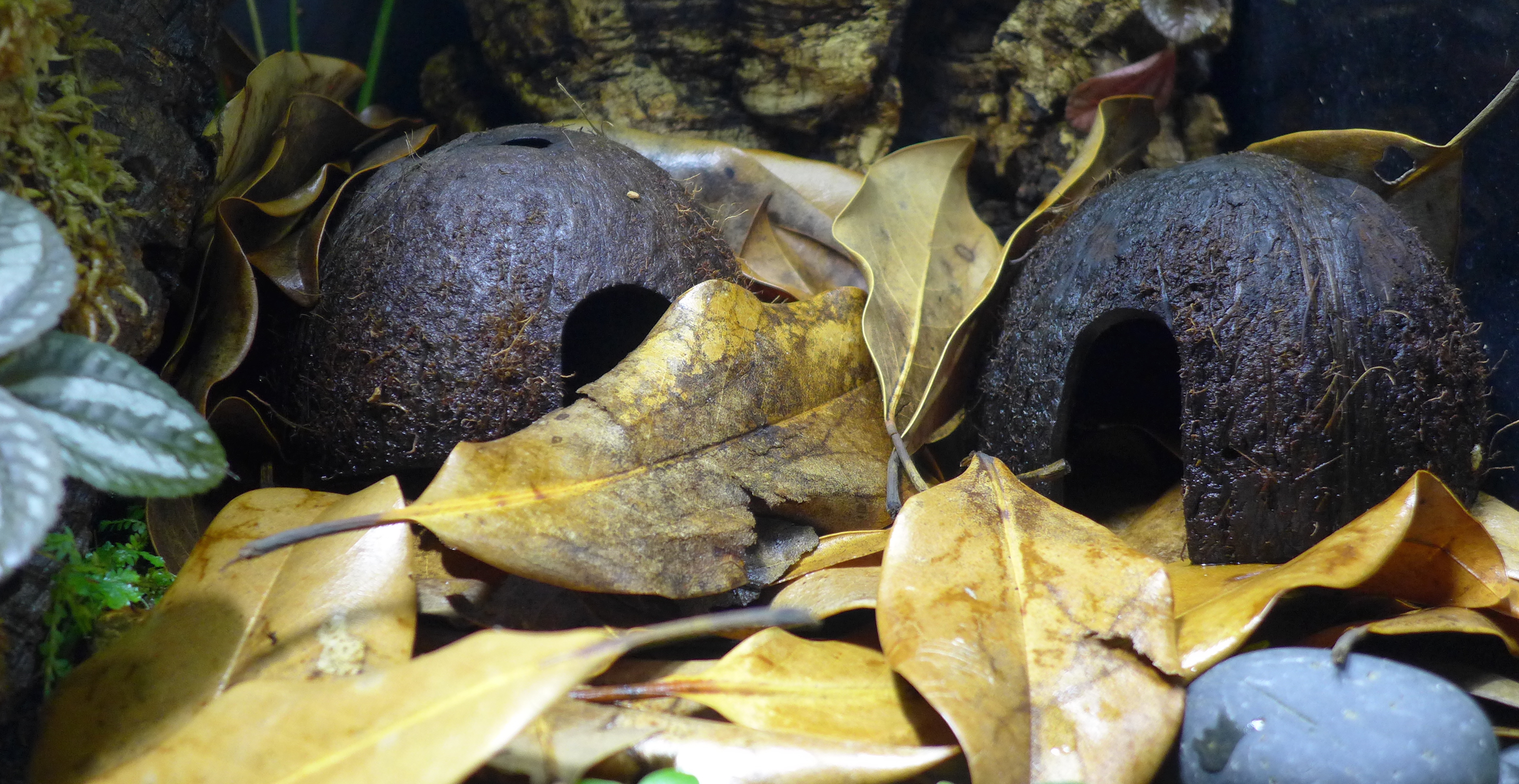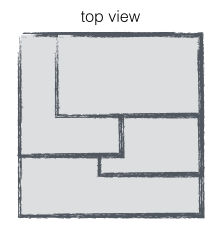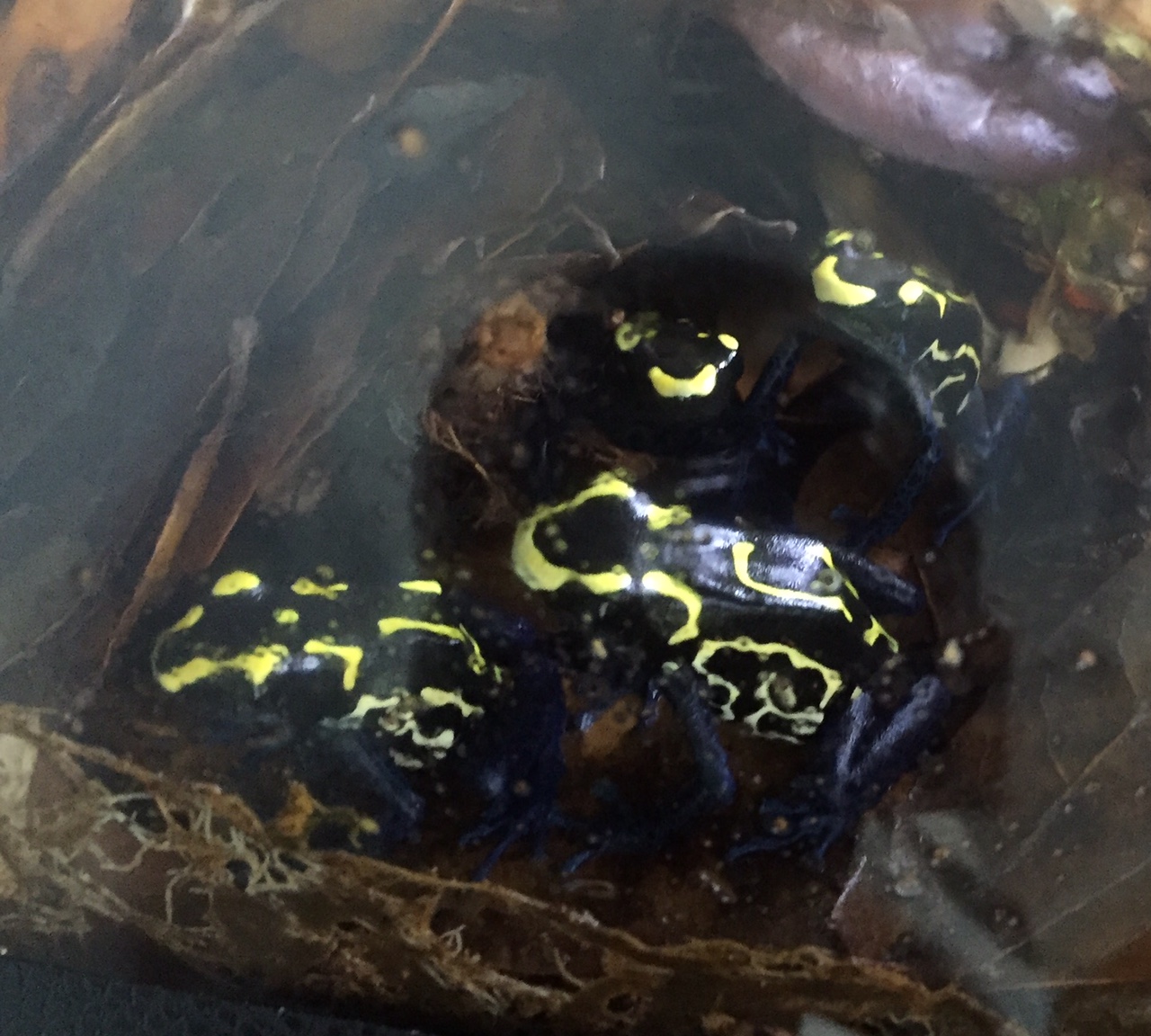I’ve seen a lot of advice on the boards telling folks that Dendrobates tinctorius morphs are “terrestrial” and “they do not climb”. These rules of thumb are incorrect – both based on my personal experience, and authoritative sources. Yes, D. tinctorius do spend time foraging on the ground, but they are also known to climb, and they will make use of all portions of a vivarium if it is constructed properly. This page discusses vivarium construction strategies that you can use to provide a more suitable home to large bodies dendrobatids, as well as tips on housing these frogs in small groups.
Back to the main dart frog page
Dendrobates tinctorius – they actually climb!
There are many references in literature to D. tinctorius climbing. One example I particularly enjoyed was the first hand account of the discovery of D. azureus (subsequently renamed D. tinctorius “azureus”):
After about 20 minutes I saw my first blue Dendrobates in the wild. It was sitting on the forest floor on fallen leaves, and when I moved nearer it hopped away with short, quick movements. Its bright blue colour contrasted beautifully with the brown dead leaves. It was easy to capture. During my trip through the creek valley I saw many more and collected some of them, restraining myself of capturing more than a few because I had no idea about the extent of the forest island and the size of the population of the blue Dendrobates. Also, at the time, I had no idea whether this species would occur in other forest islands in the region or not. Most specimens were on the ground, but a few were moving up the trunks of large trees to…..where?
http://www.sipaliwinisavanna.com/docs/discovery_of_the_blue_arrow_poison_frog.pdf
Another reference was more precise, noting that D. tinctorius were observed climbing to heights of 40 meters:
Dendrobates tinctorius is mainly terrestrial, although we observed frogs climbing tree trunks to heights of 40 m (Born 1994).
http://www.revistas.usp.br/phyllo/article/download/42724/46392
I’m sure there are other scholarly references I will eventually dig up. However based on my experience with theses animals I am quite confident in stating that they do indeed climb, and thrive in well designed vivariums with vertical hardscaping.
Using “square inches” over “gallons” as a better design metric
In many ways the frog hobby is still strongly influenced by the aquarium hobby. Many enclosures are still based on modified aquariums. This design approach typically yields inexpensive housing solutions, especially if you can obtain tanks at dollar per gallon prices at large retailers. Alternatively there are terrarium manufacturers like Exoterra and ZooMed that produce decent vertical oriented front opening enclosures that are well suited to keeping frogs. Though these enclosures also need modification for the dart frog hobby, they make a small but significant change in describing an enclosure – a move from “gallons” to dimensions. Typical orientations are described in Length x Depth x Height. This is quite helpful when describing a vivarium of ~33 gallons in capacity such as 18 x 18 x 24, or 24 x 18 x 18. In this case the base footprint of the first is 18 x 18, while the base footprint of the second is 24 x 18. This is significant since many keepers do not invest in hardscaping to increase utilization of the air space in a viv, so many keeper prefer a 24 x 18 base footprint. However, with proper design considerations, a vertically oriented 18 x 18 x 24 is a great vivarium for D. tinctorius.
Constructing a D. tinctorius friendly vivarium
All my vivarium designs incorporate cork bark ledges that provide roosting positions for D. tinctorius. I prefer a multi-tiered vertically oriented vivarium both for it’s aesthetic value, and for the ability to make better use of available space on my frog wall while meeting the housing needs of the frogs I keep. Here are examples of hardscaped and planted vertical viviarums that house D. tinctorius:






I plan my vivariums out by first considering that D. tinctorius are large bodied frogs that are capable of scaling glass, but would prefer to walk to take short hops from one ledge to another. If I provide overlapping cork ledges that also serve as planting beds, I can provide stair stepped access to the upper portions of the viv for my frogs. Viewed from the top, a standard footprint 18 x 18 x 24 would look something like this, with three ledges:

The front view shows how the ledges in this example are off set side to side to encourage the inhabitants to hop from one ledge to another. The side view shows how the ledges are set back, allowing for light penetration into the viv providing more usable planting areas:

The original vivarium had a base footprint of 18 x 18 inches, or 324 square inches. Sliding the ledges out we end up with four horizontal surfaces including the base footprint:

The base surface of 324 square inches, and three ledges of 120 + 112 + 140 square inches that total 372 square inches. The surface area of the additional ledges exceeds the size of the base footprint, increasing the usable space for my frogs by 115%.
Looking at the original premise, that D. tinctorius are terrestrial and an 24 x 18 x 18 vivarium should be used instead of an 18 x 18 x 24, we can make a few comments. First, D. tinctorius are known to climb, and our dinky little 2 foot tall box is no match for the scaling capabilities of these frogs. Second, if you are not hardscaping your viv, you are just wasting space in either viv. Third, a well design vivarium can create much more usable space in a vertically orientation than many folks expect. In the example above I increased the square inches from 324 to 696 square inches, a 115% increase. This exceeds the footprint of the 24 x 18 x 18 vivarium, 432 square inches, by 61%.
Other D. tinctorius vivarium design considerations
Here are images from a larger vivarium, 48 x 20 x 28, that houses 3.1 Dendrobates tinctorius “Robertus”. There were several design elements used to promote climbing:

Tucked away in the background you can see a series of scrap cork pieces used to make a walkway up to the ledges. It’s possible for Robertus (a large bodied tinc at 60 mm SVL) to scale the glass and get to the upper ledges, but a design element like this promotes easier access:

The most obvious design element promoting climbing is the large sloped piece of cork bark that simulates a root system. This provides an interesting visual element for the viewer of the vivarium, and an excellent sloped access to other climbing surfaces:

You can also see the interesting shadows this kind of hardscaping throws, and the additional hides the intricate cork work provides.
So don’t dismiss those vertical vivariums for housing D. tinctorius just yet. And don’t forget, if they are observed climbing in the wild to heights of up to 40 meters (120+ ft), then our little 2 to 3 ft tall boxes are quite usable by them, provided we design them with our frogs in mind.
Grouping D. tinctorius for the advanced keeper
There are two rules that are often touted on the forums as hobby dogma related to how you must keep Dendrobates tinctorius in the vivarium. The first was addressed above – tincs are not arboreal, so they won’t climb and they won’t use vertically oriented vivariums. Hopefully you see that with proper construction methods, you can take full advantage of any vivarium orientation as long as you build your hardscaping with your frog’s environment variables in mind.
The second rule that usually comes up is tincs can only be kept in pairs. Here again, we have a rule that is based on generalizations and a lack of understanding of the habitat requirements of these animals. There is no hard and fast rule to housing tinctorius. All frogs fight. I have seen the smallest thumbnails through tincs and supposed “group” frogs fight.
Whats a group?
You will see hobbyists describe their frogs with a series of 2 or 3 numbers separated by periods. The first number indicates the number of male animals in the group and the second number indicates the number of females. The third number indicates the number of unknown animals. Here are some examples:
- 1.1 = 1 male and 1 female
- 1.2 = 1 male and 2 females
- 2.1.1 = 2 males, 1 female, and 1 unknown
- 0.0.4 = 4 animals of unknown sex
Typically you will see most people recommend keeping tinctorius in 1.1 or maybe 2.1 pairs / groups. The typical argument put forward is “females fight” and will stress each other out until one of them dies. I have kept the following groupings:
- 2.2 Dendrobates tinctorius Bakhuis
- 1.3 Dendrobates tinctorius Lorenzo
- 3.1 Dendrobates tinctorius Robertus
- 1.2 Dendrobates tinctorius NAIB True Sips
- 1.2 Dendrobates tinctorius Lorenzo x 3
. The only group that I broke up because of observed stress was the 1.3 Lorenzo where 1 female was underweight. I removed her, and the 1.2 did well (both females alternately bred with the male). I currently have two 1.2 Lorenzo groups I’m experimenting with – they have only been setup for a few months, so I’m still trying to figure out if their individual behavioral traits mesh. I’m pretty confident on one of the groups, but there is a suspected female in the second group I am watching.
What do I need to do to group D. tinctorius?
I use strategies like growing out female siblings together that form the future basis for a group. Add males to vivs the females are in, or rotate males rather than females. A “tinc friendly” viv design is very important, with tiered ledges, multiple shadowy retreats per animal, and visual barriers. If I see any wrestling as the animals mature I observe any changes to their other key behavior like eating, where the roost, posture and if they are keeping on their weight.
Realize that I am not grouping animals randomly, and that if you’d like to group tincs you should consider taking a similar approach in monitoring your animals to see how they do while preparing to shuffle animals around depending on what you see (I have empty vivs on standby should I need to move an animal, but I’ve only had to move 1 female out of all these groups so far). I’m not claiming to be an expert or that I know more than someone else about tincs, I’m just sharing an alternate housing approach that has worked for me.
I wouldn’t recommend this for a beginner, but grouping tincs can be quite rewarding if you are willing to invest the time.
What might I experience with a group?




This was a fascinating sequence of a 2.2 Bakhuis group breeding with all animals participating. I am not sure if this would ever occur in a natural setting, or if this is a manifestation of their close quarters in captivity, but this was the first time I have seen the 2.2 breeding as a group.
